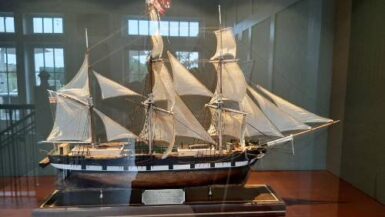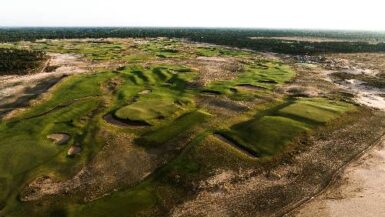
FLOURTOWN, PA – From out of the mists of history, an ancient adage still rings true: Gods and Wonders always appear to attend the birth of Kings. And with the Sun beaming so brightly it was as though Apollo himself was driving his fiery chariot through the skies once more, Philadelphia Cricket Club’s fabled Wissahickon Course re-opened in a golden blaze of glory and re-established itself as a once and future stronghold of American golf.
In this case it is actually the rebirth of a King: Philly Cricket’s 9-hole St. Martin’s course actually held two U.S. Opens, 1907 and 1910, won by Alex Ross and Alec Smith respectively. (And no, he did not go on to throw touchdown passes for the San Francisco 49ers.)
Now it’s Wissahickon, one of Golden Age architect A.W. Tilinghast’s indisputable masterpieces that will enter into the U.S. Open conversation. Merion is just too small to properly host the Open any more; the Open is too humungous an event for that wondrous, but tiny club. Last year proved that with razor-sharp clarity – 2013 was the most un-ergonomic logistical nightmare of an Open in several decades, worse than even Congressional in 2011. The U.S.G.A. forced a size 10 foot in a size 5 shoe, and no one was happy except the TV networks.
However, Merion also proved another point absolutely true: you don’t need ludicrous length and ubiquitous water hazards to challenge the greatest golfers in the world. You need curvy greens, uneven lies, reverse camber, and holes that dog-leg in awkward places. The winning score, despite record rain and soft conditions was still 1-over par. Can you imagine if it had played as fast and firm as the U.S.G.A. wanted? It would have been a replay of the Massacre at Winged Foot, with a winning score between 5 and 9-over.
That’s not golf, that’s defensive golf, a much more boring bastard brother of the game.
Happily, Merion proved all the so-called “experts” wrong. And like Merion, Wissahickon is also a strategic, thinking man’s delight. But it was a journey 92 years in the making to get it there.
“Philly Cricket was A.W. Tillinghast’s home course, as well as George Thomas’s,” explained golf architect Keith Foster, who did the restoration work. “Tillie laid out the routing in 1924, and then the idea was he would gradually add in various strategic design elements over time.”
Then in 1927-28 prominent golf course architect and Philadelphia favorite son William Flynn came in and, although he was consulted mostly for agronomic reasons, “he made some adjustments: a series of fairway bunkers at number six, and green expansion at 12 and other places. What’s interesting is that the club had a series of small plans that confirmed that Flynn was there,” explained Foster.
Besides Flynn some other hand or hands made changes to the course as well, so many that when the oldest aerial photo of the course (1938) was discovered and produced to Foster it became clear – “Someone had been tinkering with the scale of the golf course. The aerial shows a very wide range of size of holes and hazards, in particular as many different sizes and styles of bunkers,” Foster noted. “Someone else had changed the course and given it a lack of continuity – a disconnect – between the size and shape of Tillie’s work and that of the other architect or whoever it might have been.”
So now the club had a dilemma somewhat more akin to that of Sleepy Hollow Country Club. At Sleepy Hollow, their course was 12 holes Macdonald and Raynor and six holes A.W. Tillinghast. In order to give the entire 18 a contiguous look and feel of Macdonald, Gil Hanse and George Bahto had to design six new holes entirely in the style of Macdonald and Raynor. That was exactly the same fearsome challenge Foster faced: Reproduce what Tillie had done at his home club, (or would have done at his home club), had he gotten the chance.
Oh…and don’t screw it up or else your name is mud…
“I said that to myself going in – ‘Don’t mess this up!’ he laughed. “But there wasn’t much to go on, just the old aerial,” Foster confided. “So to figure out what Tillie might have put where was like solving a puzzle. I looked closely at the ground and the terrain, they were the keys. Of Tillie’s original work, we still had the routing and most of the greens. Number three green was a complete redo, and another six were either extended or reshaped into a style that wasn’t Tillie. We simply extracted what was added, and added what was meant to be there all along, like the Great Hazard at seven and Hell’s Quarter-Acre a 14.”
The results were a sparkling success. Wissahickon has not only been reborn, it’s better than ever. Already a course spoken of in holy whispers for its quaint charm, old world, fascinating asymmetrical routing, and fearsome greens, now that a buffet of Tillie’s favorite design tricks have been added, golfers are eager as gun dogs who heard the owner take the firing piece off the wall for a chance to see Wissahickon’s old and new wonders first hand.

Here’s a breakdown of the major revisions and restorations:
—First, the club built a new terrace so near the 18th green and first tee that someone may get a Titleist in their snapper soup or soft-shell crab appetizer. That gives the start to the round a homespun feel – walk mere steps to the first tee, wave to your friends on the veranda, and don’t hit a ground ball to the second baseman, or you’ll endure waves of laughter from the spectators;
—The new green at the pint-sized, but dangerous par-3 third hole is a complete redesign. With so much of the golf world only seeing Tillie’s holes stretched on a rack by the U.S.G.A. and PGA of America, it’s nice to see Tillie’s shorter, sexier holes get the accolades they deserve. Much like the short par-3 third hole at Paramount C.C. or the fourth hole at Baltimore Five Farms, the hole is a great change of pace for an amateur golfer, yet still has plenty of challenge being surrounded by trouble and having curvaceous green contours so that the pros are just as nervous with a wedge in their hands as we mere mortals are. Miss the green and you’re begging for a par;
—Then the club re-sequenced the holes back to the 1930s routing, switching holes four-five-and-six with holes seven-eight-and nine. This provides changes of pace to the round – short-long-short-long, uphill-downhill, and so forth…
“We returned to Tillie’s original sequencing, the one used in the ’36 PGA Championship,” Foster recalls. “Four and seven – two of my absolute favorite holes by the way – are parallel holes that play completely differently. Four is now a looooooong par-4 with a really cool strategy. The hole is straight from tee to green, but the bunkering on the tee is on the left and the approach bunkers are on the right, so it’s draw off the tee and fade into the green – the bunkering turns a straight hole into a strategic hole!”
And that’s another strong and eminently fair defense to scoring – alternating shot patterns. Holes like six and eight, where you must shape your shot one way off the tee, then the other on the approach, ensure that the golfer doesn’t get into a groove or comfort zone, repeating the same swing over and over again. Golfers must constantly be alert to what shot shapes the course requires and then plan and execute the proper shot rather than over powering the course with bomb and gauge. Like Merion, some short holes on the card are much tougher on the course because they turn in awkward places. A straight ball may buy you as much trouble at Wissahickon as it will at Olympic Club or Merion. Brute force often just leaves you a terrible angle to the green, if you haven’t run through the fairway into the rough, that is.
“It’s a thinking mans course all the way around,” said member Dan Prochniak. “It never plays the same way twice, even when you’re playing 36 on the same day…”;
—Then there’s the Great Hazard at 7, a half-acre sized dunescape of mounds, shaggy rough, and steep-lipped bunkers crossing the entire hole in the second shot landing area. It reintroduces perhaps Tillie’s favorite hazard in his repertoire, one he repeated at many of his best courses, including Bethpage Black.
“This hole is a great counter-point to four, even though they run parallel to each other,” Foster states energetically. Here you have the short, but dangerous par-5 seventh with the iconoclastic Tillie hazard becoming one of several centerpieces of the golf course, right next to a hole nearly the same length and running in the same direction, but while both holes are essentially a par 4-1/2, they offer completely different shot requirements.
Now the Great Hazard isn’t there just to make architecture experts and course raters jump for joy, it’s there to terrorize your scorecard. So course Head Superintendent Dan Meersman offers this sage advice to anyone grousing that they had a bad lie or tough shot:
“It’s not just a hazard, it’s ‘The Great Hazard,’ [Author’s Note: The Definitive Article!] so you should expect a bad or uneven lie if you get in it. If you don’t want to get penalized, don’t hit it in there. But of all the great things Foster and the club have done here, it’s the Great Hazard that screams ‘Tillinghast,’ ‘strategic golf,’ and ‘Golden Age’ the loudest.”

—The club moved the 10th green a few yards to the right so that there’s less of a chance of double-crossing a 9-iron into the club parking lot.
“We used the start-of-the-art green scanning and replicating technology and just rebuilt the entire green perfectly, just a few feet further away,” explained Meersman.
As an aside, the club’s asymmetric routing of “Front 10-Back 8” is one of those differences from other golf courses that gives Philly Cricket its unique character and charm. There is something almost cinematic about the way the front 10 unfolds, and we’re talking “Citizen Kane cinematic,” golf on the grandest scale. There is an almost perfect tempo and pace of those ten holes that is both exciting and one-of-a-kind. To cite another example, perhaps no other truly great course except Rockaway Hunting Club comes back to the clubhouse at two, a bit of eccentricity at Philly Cricket almost comical in its requirement that the golfer try to avoid not smacking the clubhouse with a pushed or sliced approach shot.
“I’ve taken a walk of shame up that fairway after whacking one off the clubhouse. What’s worse is everyone comes out to see who it was, then watches you blade one over the green, stub one out of the rough, then 3-putt,” said one golfer who begged for anonymity. “And to top it off, then the pro came running out to the green to hand me the three wedges I left at the practice range, so I guess it’s convenient for boneheads like me that do that as well,” he quipped self-effacingly.
“I love Philly Cricket because it takes stupid ‘rules’ like ‘Your course must be symmetrical’ and ‘You can’t have 10 be a par-3’ and ‘You must have this many par-5s and par-3s’ and shows how wrong they are, and how great a course you can design when you’re not constricted by artificial boundaries made up by who knows who!” adds Foster. “That’s what makes Philly Cricket so special – those unique, charming aspects that distinguish the course. There’s no other course in the world like it.”
—Next several greens, including 12 and 13 were extended back to the original sizes of their green pads;
—Finally, 14-15-16, the cervical spine of the back nine, have seen the addition of the “Hell’s Quarter-Acre” hazard, a smaller version of the Great Hazard at 7 which has the gorgeous par-3 15th behind it set in serene tableau as you march down the fairway, followed by the new tee box on the uphill par-4 16th with its new diagonal carry to the fairway.
There are other significant changes as well – 2000 trees were taken down according to Foster. Many of the fairways blend perfectly seamlessly into the greens, and the rough is deliberately kept low and playable – around 2-1/2 inches or so – so the recovery shot is still an important part of the golfer’s arsenal.
“The new fescues are not only more playable, but they are more sustainable too. They are more draught tolerant and offer a great texture and color to the golf course,” Meersman says poignantly. “In the field of play you have the shorter fescues. Then, far off line, you have the taller, thicker fescues. But you really have to hit one almost completely off the golf course to end up in that. Again, if you hit the ball 70 yards off line, it’s not our fault if you can’t find the ball. At 70 yards off line the look of the rough trumps finding the ball, so don’t hit it 70 yards off line,” he says with a smile.
You can’t disagree with him. Nothing good happens when you hit it that far off line. Just ask Phil Mickelson, Dustin Johnson, or Jean Van de Velde.
All in all, the restoration was nothing short of a monumental success. If, as an old mentor of mine used to say, “The proof of the pudding is in the tasting,” then the myriad accolades golfers and pundits are already heaping upon Philly Cricket is the true measure of the success of the work.
“Tillie would be proud,” gushed Tom Lipscomb, the superintendent at River Bend, another course being restored by Keith Foster. “The new bunkering not only brings back the old look and feel of the Golden Age and Tillie but, best of all, it’s perfectly seamless with the rest of the golf course.”
“The wide fairways give every golfer a fighting chance to play the course and still recover from a bad shot,” added bogey golfer Jeff Downing, perhaps just saying what the majority of members are thinking. “It’s tough, but it’s totally fair, and there’s something new and cool around every corner. You can play here every day and never get bored,” he concluded with a smile.
Indeed, retire the trophy right now: If Philly Cricket doesn’t sweep every major “Best Restoration” award, there should be an inquiry. One journalist called Re-Opening Day “The Event of the Year in Golf Design” and he’s probably right.
“The handcuffs were off to let Foster put back what Tillie had there originally and what he wanted to do, and that’s exactly what Foster did. We trusted him, and he responded with all the club could have asked for and more,” a grateful Meersman summarized triumphantly.
Is a U.S. Open in the course’s future? It sure fits the mould of a classic Golden Age venue a la Merion, Oakland Hills, and Oakmont. It tests your patience and your skill. It has the length, the strong routing, and the curvaceous green contours needed to send the pros running for their Pepto-Bismol. They have plenty of room for the galaxy of extemporaneous tents and TV compounds needed for a major championship infrastructure. The one problem Wissahickon may face in hosting an Open is where to put the grandstands on 18 – the clubhouse comes so close to the finishing green, there’s no room for it. Perhaps the solution would be to make as much of 18 a stadium hole as possible, but we are speculating idly. In the six to eight years it would take from naming the course as an Open venue to the day the first tee shots would be struck much and more can happen, and earnest minds and hearts can find a creative solution. And Lord knows they have plenty of earnest minds and hearts at Philly Cricket, starting with Foster himself.
“I’m so grateful I got his job. It’s a sort of homecoming for me too as I was born here,” Foster reminisced fondly. “But my greatest joy in the project was being of service to Tillinghast’s home course. I mean he loved this place so much he had his ashes sprinkled in the Wissahickin River when he was laid to rest. I feel that strongly about the place too. I love everything about Philly Cricket…even the great logo!”
I wish I could agree with him on that, but too many lunkheads look at the cover on my 5-wood and ask me ask me why I’m rocking Chicago Blackhawks gear when I’m a Pittsburgh Penguins fan! No, it’s not the Chicago Blackhawks, dammit!
And just as Apollo opened the day with sunbeams, Zeus closed it with thunderbolts, lightning, and winds. At sunset, a storm out of the pages of the last judgment hurtled through the course with Olympian fury, sending golfers scurrying like rabbits for cover…there’s a bunch of new Pro V-1s all over the course, laying right where they were left by fleeing players outracing the thunderstorm to the safety of the clubhouse.
As an aside, the only thing funnier than watching overweight, middle-age men run their first quarter-mile dash in twenty years is watching models eating pasta. (They eat the whole dish one penne at a time…and promise each other, “This is the LAST ONE!” over and over again.)
The storm didn’t just turn golfers into track stars; it claimed a tree just off the first fairway, a tree everyone ran past on the way back to the clubhouse. Zeus made his presence known and exacted his price, but that’s all right. In fact, it’s actually to be expected. After all – Gods and Wonders always appear to attend the rebirth of Kings.





